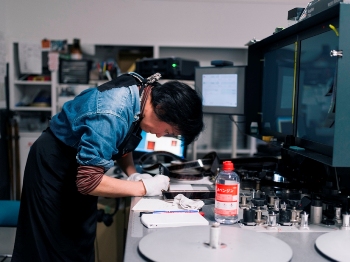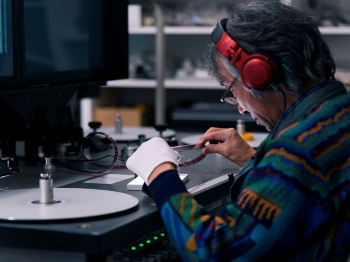収集・保存・復元
国立映画アーカイブが行う収集・保存・復元
- 映画保存とフィルムアーカイブの活動の現状に関するQ&Aはこちら。
- 当館も加盟する国際フィルムアーカイブ連盟(FIAF)は、70周年を迎えた2008年、新たなスローガン「映画フィルムをすてないで!」を発表しました。詳しくはこちらをご覧ください。


収集
国立映画アーカイブでは、日本映画、外国映画を問わず、残存フィルムを可能な限り収集することを原則に、劣化の進行や廃棄・散逸の危険があるフィルム、希少性の高いフィルム、上映や国際交流事業に必要なフィルム等を優先して、計画的な収集を行っています。また、図書、ポスター、スチル写真といった映画関連資料(ノンフィルム資料)についても網羅的な収集に努めています。
所蔵映画フィルム数(2025年3月末時点)
所蔵日本/外国映画の内訳
- 日本映画
-
- 劇映画
- 15,026本
- 文化・記録映画
- 33,012本
- アニメーション映画
- 2,902本
- ニュース映画
- 17,182本
- テレビ用映画
- 10,958本
- その他
- 2本
- 小計
- 79,082本
- 外国映画
-
- 劇映画
- 6,603本
- 文化・記録映画
- 3,382本
- アニメーション映画
- 402本
- ニュース映画
- 189本
- テレビ用映画
- 468本
- 小計
- 11,044本
- 合計
- 90,126本
- ここで用いている「本」とは、1つの作品に対し、ジェネレーション(ポジ、ネガ)、形状(35mm、16mm等)、バージョン(再編集版、字幕付きプリント等)、完全度において異なるフィルムを1つずつ数えた場合の単位を指しています。つまり、1つの作品に対して複数本のフィルムが存在していることがあります。
所蔵映画関連資料数(2025年3月末時点)
- 映画関係図書(和書)
- 50,406点
- 映画関係図書(洋書)
- 5,822点
- シナリオ
- 約52,000点
- ポスター
- 約64,000点
- スチル写真
- 約837,000点
- プレス資料
- 約98,000点
- 技術資料
- 約800点
保存・復元
寄贈や購入などで受け入れたフィルム(デジタル作品を含む)は、検査員による検査を経て相模原分館に保管されるとともに、目録化されます。劣化や損傷が見られたり、その危険性があるフィルムや希少性の高いフィルム、滅失の危険がある可燃性フィルム等については、複製作業を通じ、長期保管を図るための保存に努めています。また、芸術的、歴史的、資料的に価値の高い映画フィルムについては、コンテンツのより忠実な再現をめざし、高度な技術による復元を行っております。近年では『羅生門』、『銀輪』、小津安二郎監督カラー4作品、『日本南極探檢』等の復元を実施し、『羅生門』のデジタル復元は、全米映画批評家協会賞を受賞しました。
またポスター・スチル写真・シナリオ・プレス資料・技術資料といった映画関連資料についても、目録化を行った上で、適切な温湿度環境での保存に努めるとともに、材質に応じた修復も行っています。
3つの映画保存棟を有する国立映画アーカイブ 相模原分館の施設紹介は、こちらをご覧ください。
FIAF70周年記念マニフェスト
「映画フィルムをすてないで!」
国立映画アーカイブも加盟する国際フィルムアーカイブ連盟(FIAF)は、設立から70年を迎えた2008年に新たなスローガン「映画フィルムをすてないで!」を提起し、以下の声明を発表しました。
FIAFについてはこちらをご覧ください。
FIAF70周年記念マニフェスト 「映画フィルムをすてないで!」
映画フィルムは、わたしたちの文化遺産の欠くことのできない一部であり、また、わたしたちの歴史と生活のユニークな記録ともなっています。フィルム・アーカイブは、公的なものも私的なものも、そうしたフィルムを収集し、安全に保管し、文書化し、現在の人々と未来の世代とが、研究のためあるいは楽しみのために、それらを利用できるようにすることに責任を負っている機関です。
現在、65を越える国々から130以上の加盟がある国際フィルムアーカイブ連盟(FIAF/フィアフ)とその会員機関は、過去70年にわたって200万以上の映画フィルムを救済してきました。その一方で、特定のジャンルや地域、映画史の時代区分については、その映画作品残存率が10%を大きく下まわっているという事実も知られています。
FIAFはその70周年を機に、世界に向かって新たなスローガン「映画フィルムをすてないで!」を提起します。もしあなた自身のところできちんと映画を保管しておくことができないのなら、FIAFとその会員機関は喜んでそれができるアーカイブを探す手助けをいたします。映画フィルムは、文化的にかけがえのないものであり、それが特に専門家の手にあれば、長期にわたって存続できるものなのです。
今日の映像技術が、デジタルの分野で達成される発展を力にして前進していることは十分に認めつつも、しかしFIAF会員は、今後も映画フィルムを収集しフィルムとして保存し続けることを決意しています。この方針は、デジタル・ボーンの映像遺産を保存するための効果的な方法の開発に対して相互補完的な関係をもつことになります。映画を作りまた保管する、プロとアマチュアとを問わないすべての人々に、また、世界の映画遺産を安全保護することに責任をもつすべての政府関係者に対して、FIAF加盟機関は、強くこの使命遂行への協力を求めます。
「映画フィルムをすてないで!」というスローガンは、フィルムの所有者が、そのフィルムを、より安定したフィルム・キャリアに転写することによって、あるいは明らかに重大な情報欠損を引き起こすことがない解像度でデジタル・ドメインにスキャンすることによって、フィルムのコンテンツを適切に確保し得たと考えたとしても、当のフィルムを投棄・廃棄してはならない、ということを意味しています。フィルム・アーカイブやミュージアムが映画フィルムをフィルムのまま保存することを決意しているのには、次のような理由があります。
- 映画フィルムは、映画作家の直接的な監督のもとに創造されたもの、あるいはカメラマンによって捕らえられた歴史的瞬間の記録です。いずれのタイプであれ、それらはますます重要となる可能性を秘めた人造物であり、世界の文化遺産の一部です。フィルムは手で触れることができ、目で読み取ることができるモノであり、美術館・博物館が所蔵する作品や歴史的文物と同様に、慎重な取り扱いを必要とします。
- 映画フィルムは物理的・化学的に脆弱であるとも言えますが、適正に保管され怠りなく扱われれば何世紀にもわたって存続できる安定した素材であるとも言えます。その寿命は、のちに開発されたビデオテープのような映像キャリアなどよりもはるかに長いということがすでに証明されています。一方、デジタル情報は、機械的な読み取り/翻訳がなければ価値をもたず、また、デジタル情報が載っているキャリア素材は、物理的・化学的な劣化に対して十分な耐久性を持たず、さらに読み取り/解釈に必要なハードウェアやソフトウェアは陳腐化を免れません。
- 映画フィルムは現在のところ映像にとって最良の長期保存メディアです。それはわれわれが手にすることのできる製品のなかでもっとも標準化され国際化されたものの一つであり、今も高解像度メディアとしての可能性を秘めています。フィルムに含まれる情報は定期的な移し替え(マイグレーション)を必要とせず、また、その操作システムの頻繁な更新を必要としません。
- アーカイブの倉庫に保管されているさまざまなフィルムは、そこからあらゆる複製物が作られる原版素材です。それらから複製物の完全さ不完全さが判定されます。デジタル技術が進歩すればするほど、映像の内容に手を加えたり、恣意的に改変することが容易になってしまいます。しかしながら、不正な改変や不当な歪曲が行われたとしても、もとのフィルムが適切に保管されていれば、比較することによって、いつでもそうした違いを見つけだすことができます。
映画フィルムを決してすてないで!――たとえ、あなたが何か良い新製品が現れたと思ったとしても。将来、どんな映像技術が現れたとしても、今あるフィルムのコピーこそは、わたしたちを過去の業績と確かな何かとに結びつけてくれているのです。フィルム・プリントは存続します。フィルムをすてないで!
2008年4月、パリ(2008年7月・9月に改正)
The FIAF 70th Anniversary Manifesto “Don’t Throw Film Away”
Motion picture film forms an indispensable part of our cultural heritage and a unique record of our history and our daily lives. Film archives, both public and private, are the organizations responsible for acquiring, safeguarding, documenting and making films available to current and future generations for study and pleasure.
The International Federation of Film Archives (FIAF) and its affiliates comprising more than 130 archives in over 65 countries have rescued over two million films in the last seventy years. However for some genres, geographical regions and periods of film history the survival rate is known to be considerably less than 10% of the titles produced.
On the occasion of its 70th anniversary, FIAF offers the world a new slogan: “DON’T THROW FILM AWAY”. If you are not sufficiently equipped to keep film yourself, then FIAF and its members will gladly help you locate an archive that is. Film is culturally irreplaceable, and can last a long time, especially in expert hands.
While fully recognizing that moving image technology is currently driven by the progress achieved in the digital field, the members of FIAF are determined to continue to acquire film and preserve it as film. This strategy is complementary to the development of efficient methods for the preservation of the digital-born heritage. FIAF affiliates urge all those who make and look after films, whether they be professionals or amateurs, and the government officials in all nations responsible for safeguarding the world cinema heritage, to help pursue this mission.
The slogan “DON’T THROW FILM AWAY” means that film must not be discarded, even though those who hold it may think they have adequately secured the content by transferring it onto a more stable film carrier or by scanning it into the digital domain at a resolution which apparently does not entail any significant loss of data. Film archives and museums are committed to preserve film on film because:
- A film is either created under the direct supervision of a filmmaker or is the record of an historical moment captured by a cameraman. Both types are potentially important artifacts and part of the world’s cultural heritage. Film is a tangible and “human-eye readable” entity which needs to be treated with great care, like other museum or historic objects.
- Although film can be physically and chemically fragile, it is a stable material that can survive for centuries, as long as it is stored and cared for appropriately. Its life expectancy has already proved much longer than moving image carriers like videotape that were developed after film. Digital information has value only if it can be interpreted, and digital information carriers are also vulnerable to physical and chemical deterioration while the hardware and software needed for interpretation are liable to obsolescence.
- Film is currently the optimal archival storage medium for moving images. It is one of the most standardized and international products available and it remains a medium with high resolution potential. The data it contains does not need regular migration nor does its operating system require frequent updating.
- The film elements held in archive vaults are the original materials from which all copies are derived. One can determine from them whether a copy is complete or not. The more digital technology is developed, the easier it will be to change or even arbitrarily alter content. Unjustified alteration or unfair distortion, however, can always be detected by comparison with the original film provided it has been properly stored.
Never throw film away, even after you think something better comes along. No matter what technologies emerge for moving images in the future, existing film copies connect us to the achievements and certainties of the past. FILM PRINTS WILL LAST – DON’T THROW FILM AWAY.
April 2008, Paris (revised, July/September 2008)
Acknowledgements:
The FIAF 70th Anniversary Manifesto was originally drafted as FIAF Appeal by Hisashi Okajima in 2007, based on his inspiration first suggested in 2005 in his mission statement for Executive Committee membership of FIAF. The draft was thoroughly refined by David Francis, fully elaborated and edited by Roger Smither, with invaluable advices from Paolo Cherchi Usai, Robert Daudelin, Edith Kramer and Paul Read, and with the consultation of the current EC members of FIAF. Translation to French was done by Robert Daudelin, and to Spanish by Christian Dimitriu.
The Manifesto was adopted in principle by the majority of those attending the FIAF General Assembly in Paris, after discussion that included a number of reasonable suggestions for improvements. As agreed in the proposal that was put to the vote, these have been discussed by a team appointed by the Executive Committee, which has produced this final text. The team consisted of Paolo Cherchi Usai, Roger Smither, Hisashi Okajima and Eva Orbanz. Contributions to the final editing process were also received from Ivan Trujillo, Alexander Horwath and Maria Bustamante.
